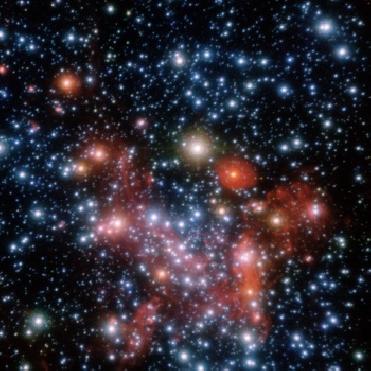
This artistic concept shows the dimmest star-like bodies currently known -- twin brown dwarfs referred to as 2M 0939. Photo credit -- NASA
NEW YORK (BNS): A team under the leadership of Massachusetts Institute of Techonology (MIT) physicist Adam Burgasser has discovered two faintest star-like objects ever found, a pair of twin 'brown dwarfs' each just a millionth as bright as the Sun.
According to Burgasser, the two brown dwarfs are the lowest power stellar light bulbs in the sky that man knows of. "In this regime of faintness we expect to find the bulk of the brown dwarfs that have formed over the lifetime of the galaxy. So, in that sense these objects are the first of these 'most common' brown dwarfs, which haven't been found yet because they are simply really faint.�
In a paper published in the December 10 issue of the Astrophysical Journal Letters, Burgasser said both of these objects are the first to break the barrier of one millionth the total light-emitting power of the Sun.
Astronomers had thought the pair of dim bulbs was just a single typical, faint brown dwarf with no record-smashing titles.
Burgasser and his team later used NASA's Spitzer Space Telescope to observe the brown dwarf in infrared light; it was able to accurately measure the object's extreme faintness and low temperature for the first time. The Spitzer data revealed that what seemed to be a single brown dwarf, was in fact a twin.
�Brown dwarfs are compact balls of gas floating freely in space, too cool and lightweight to be stars but too warm and massive to be planets�.
"The name 'brown dwarf' comes from the fact that these small star-like bodies change colour over time as they cool, and thus have no definitive colour. In reality, most brown dwarfs would appear reddish if they could be seen with the naked eye," he said.
Later physicist team used Spitzer's ultra sensitive infrared vision to learn more about the object, thought to be a solo brown dwarf, the data revealed a warm atmospheric temperature of 565 to 635 Kelvin (560 to 680 degrees Fahrenheit).
While this is hundreds of degrees hotter than Jupiter, it's still downright cold as far as stars go. In fact, the brown dwarfs, called 2MASS J09393548-2448279, or 2M 0939 for short, are among the coldest brown dwarfs measured so far.
To calculate the object's brightness, the researchers had to first determine its distance from the Earth. After three years of precise measurements with the Anglo-Australian Observatory in Australia, they concluded that 2M 0939 is the fifth closest known brown dwarf to man, 17 light-years away toward the constellation Antlia. This distance together with Spitzer's measurements told the astronomers the object was both cool and extremely dim.
Burgasser said studying these objects could help astronomers understand details of brown dwarf structure and evolution. "These observations allow us to see for the first time what the atmospheres of very old and/or very low mass brown dwarfs contain and how they are structured�.
 Previous Article
Previous Article Next Article
Next Article













The Indian Air Force, in its flight trials evaluation report submitted before the Defence Ministry l..
view articleAn insight into the Medium Multi-Role Combat Aircraft competition...
view articleSky enthusiasts can now spot the International Space Station (ISS) commanded by Indian-American astr..
view article